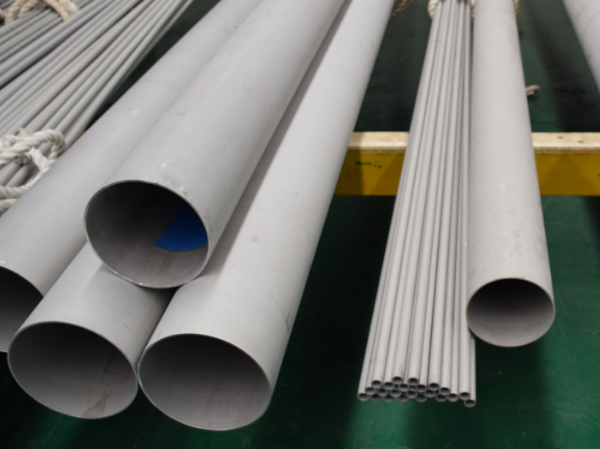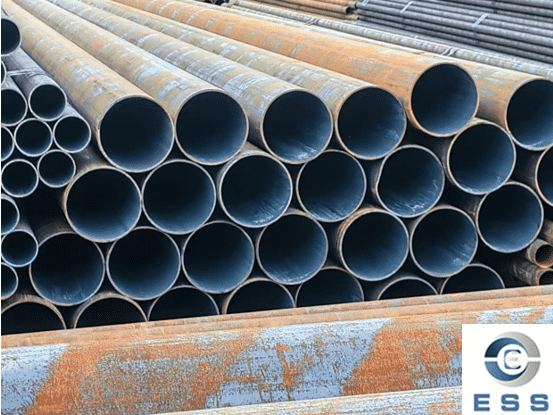Seam pipes, also called welded steel pipes, are made of easy-to-weld carbon steel. Welded steel pipes are also called water and gas pipes because they are often used for the transportation of cold, hot water and gas.
Seamless steel pipe is relative to welded steel pipe. Welded steel pipes are made of steel plates/coils with welds; while seamless steel pipes are perforated and rolled from blanks without welds.
Stainless steel pipe is a hollow long round steel, which is widely used in petroleum, chemical, medical, food, light industry, mechanical instrumentation and other industrial pipelines and mechanical structural parts. In addition, when the bending and torsion strength are the same, the weight is lighter, so it is also widely used in the manufacture of mechanical parts and engineering structures. It is also often used to produce various conventional weapons, barrels, shells, etc. Stainless steel pipes are divided into seamless stainless steel pipes and welded stainless steel pipes.

The difference between seamed stainless steel pipe and seamless stainless steel pipe:
1. Concentricity
The manufacturing process of seamless pipes is to punch a hole in a stainless steel billet at a temperature of 2200°f. At this high temperature, the tool steel is punched and drawn to become soft and spirally formed from the hole. In this way, the wall thickness of the pipeline is uneven and the degree of eccentricity is high. Therefore, ASTM allows the wall thickness difference of seamless pipes to be greater than that of seamed pipes. The slotted pipe is made of precise cold-rolled sheet (with a width of 4-5 feet per coil). These cold rolled sheets usually have a maximum wall thickness difference of 0.002 inches. The steel plate is cut to a width of πd, where d is the outer diameter of the pipe. The tolerance of the wall thickness of the slotted pipe is very small, and the wall thickness is very uniform throughout the circumference.
2. Welding performance
Generally, there is a certain difference in the chemical composition of seamed pipes and seamless pipes. The steel composition for the production of seamless pipes is only the basic requirement of astm. The steel used for the production of seamed pipes contains chemical components suitable for welding. For example, the mixing of elements such as silicon, sulfur, manganese, oxygen, and triangular ferrite in a certain proportion can produce a weld melt that is easy to transfer heat during the welding process, so that the entire weld can be penetrated. Steel pipes lacking the above chemical composition, such as seamless pipes, will produce various unstable factors during the welding process, and are not easy to weld firmly and impermeably.
3. Grain size
The grain size of the metal is related to the heat treatment temperature and the time to maintain the same temperature. The grain size of the annealed slit stainless steel tube and seamless stainless steel tube are the same. If the seam pipe adopts the minimum cold treatment, the grain size of the weld is smaller than the grain size of the welded metal, otherwise, the grain size is the same.
4. Pipe strength
The strength of the pipeline depends on the alloy composition, so the seamless stainless steel pipe and the seamed stainless steel pipe containing the same alloy and the same heat treatment are essentially the same in strength.
After the tensile test and the three-dimensional vibration test, the tearing of the seamed stainless steel pipe almost all occurred in a place far away from the welding point or the heated area. This is because the weld is less impurity and the nitrogen content is slightly higher, so the strength of the weld is better than other parts. However, ASME (American Society of Mechanical Engineers) believes that seamed stainless steel pipes can only withstand 85% of the allowable pressure. This is mainly due to the collection of data earlier than the improved welding equipment used today.
ASME stipulates that 100% of the seamed stainless steel pipes that have passed the ultrasonic test can fully withstand the allowable pressure. Similarly, Europe and Asia also stipulate that seamed stainless steel pipes that pass the eddy current test can guarantee the high quality of their welding performance. The eddy current test needs to go through a legal procedure and be carried out by a licensed organization. The eddy current test of TRENT has passed the permission of the Swedish Ministry of Power. ASME believes that the small current loss is based on the high-quality performance of the seam pipe.
5. Corrosion resistance
The corrosion resistance also depends on the composition of the alloy. The corrosion resistance of seamless stainless steel pipes with the same chemical composition and fully heat-treated seamed stainless steel pipes is the same. The supplementary test provided by ASTM proves that the corrosion resistance of the weld is equal to or better than that of the metal being welded. In an acid chloride environment, the corrosion of welded joints of incompletely heat-treated seam steel pipes will accelerate, but this is only required for corrosion testing. In fact, the environment is not so harsh.
6. Flexibility and extensibility
The extensibility of the weld can be verified by the following test specified by ASTM: bend 45°, then bend to 90°, and then flatten along the weld; then turn the stainless steel seam pipe and repeat the above steps to make the weld bend inner diameter to 180° . The standard for welding seam quality is that no tearing or intergranular separation is allowed under the condition of 40 times magnification. The bending radius of the pipe is controlled by the composition of the alloy, and the minimum bending radius is generally 2d. The ideal welding condition is that the weld is in a neutral or compressed state. Moreover, the pipeline should be annealed to reduce its hardness, thereby improving the bending performance.
7. Price
The price of seamed stainless steel pipe is usually only half of that of stainless steel seamless pipe.
8. Wall thickness/diameter
Thin-walled stainless steel pipes with small thickness/diameter values are best produced by welding; thick-walled pipes with large thickness/diameter values are best produced by stamping.
9. Comprehensive quality
Generally, the quality of seamed stainless steel pipes is better than seamless stainless steel pipes, because the seamed stainless steel pipes are made of accurate cold-rolled plates that have passed inspections, so any defects are limited to the weld. Seamless pipes are stamped from stainless steel blanks by punches, resulting in many tearing phenomena in the pipe wall formed by extrusion. The eddy current test shows that the defective rate of seamed stainless steel pipes is generally lower than that of seamless stainless steel pipes. Using ultrasonic testing, the background noise of seamless stainless steel pipes is so great that it is difficult to find defects. The background noise of the seamed stainless steel pipe is very low, and the defect is easy to find.













 Eastern Steel Manufacturing Co.,Ltd not only improve product production and sales services, but also provide additional value-added services. As long as you need, we can complete your specific needs together.
Eastern Steel Manufacturing Co.,Ltd not only improve product production and sales services, but also provide additional value-added services. As long as you need, we can complete your specific needs together.










